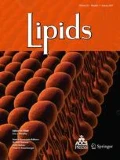Abstract
Fatty acid α-hydroxylase, a cytochrome P450 enzyme, from Sphingomonas paucimobilis, utilizes various straight-chain fatty acids as substrates. We investigated whether a recombinant fatty acid α-hydroxylase is able to metabolize phytanic acid, a methyl-branched fatty acid. When phytanic acid was incubated with the recombinant enzyme in the presence of H2O2, a reaction product was detected by gas chromatography, whereas a reaction product was not detected in the absence of H2O2. When a heat-inactivated enzyme was used, a reaction product was not detected with any concentration of H2O2. Analysis of the methylated product by gas chromatography-mass spectrometry revealed a fragmentation pattern of 2-hydroxyphytanic acid methyl ester. By single-ion monitoring, the mass ion and the characteristic fragmentation ions of 2-hydroxyphytanic acid methyl ester were detected at the retention time corresponding to the time of the product observed on the gas chromatogram. The K m value for phytanic acid was approximately 50 μM, which was similar to that for myristic acid, although the calculated V max for phytanic acid was about 15-fold lower than that for myristic acid. These results indicate that a bacterial cytochrome P450 is able to oxidize phytanic acid to form 2-hydroxyphytanic acid.
Similar content being viewed by others
Abbreviations
- FAAH:
-
fatty acid α-hydroxylase
- GC-MS:
-
gas chromatography-mass spectrometry
- P450:
-
cytochrome P450
References
Yabuuchi, E., Yano, I., Ovaizu, H., Hashimoto, Y., Ezaki, T., and Yamamoto, H. (1990) Proposals of Sphingomonas paucimobilis gen. nov. and comb., Sphingomonas parapaucimobilis sp. nov., Sphingomonas yanoikuyae sp. nov., Sphingomonas adhaesiva sp. nov., Sphingomonas capsulata comb. nov., and two Genospecies of the Genus Sphingomonas. Microbiol. Immunol. 34, 99–119.
Matsunaga, I., Yamada, M., Kusunose, E., Miki, T., and Ichihara, K. (1998) Further Characterization of Fatty Acid α-Hydroxylase from Sphingomonas paucimobilis, J. Biochem. 124, 105–110.
Matsunaga, I., Yamada, M., Kusunose, E., Nishiuchi, Y., Yano, I., and Ichihara, K. (1996) Direct Involvement of Hydrogen Peroxide in Bacterial α-Hydroxylation of Fatty Acid, FEBS Lett. 386, 252–254.
Matsunaga, I., Yokotani, N., Gotoh, O., Kusunose, E., Yamada, M., and Ichihara, K. (1997) Molecular Cloning and Expression of Fatty Acid α-Hydroxylase from Sphingomonas paucimobilis, J. Biol. Chem. 272, 23592–23596.
Gotoh, O. (1993) Evolution and Differentiation of P450 Genes, in Cytochrome P450 (Omura, T., Ishimura, Y., and Fujii-Kuriyama, Y., eds.) 2nd edn., pp. 255–272, Kodansha, Tokyo.
Narhi, L.O., and Fulco, A.J. (1986) Characterization of a Catalytically Self-Sufficient 119,000-Dalton Cytochrome P-450 Monooxygenase Induced by Barbiturate in Bacillus megaterium, J. Biol. Chem. 261, 7160–7169.
English, N., Palmer, C.N.A., Alworth, W.L., Kang, L., Hughes, V., and Wolf, C.R. (1997) Fatty Acid Signals in Bacillus megaterium Are Attenuated by Cytochrome P-450-Mediated Hydroxylation, Biochem. J. 327, 363–368.
Tsai, S.-C., Avigan, J., and Steinberg, D. (1969) Studies on the α-Oxidation of Phytanic Acid by Rat Liver Mitochondria, J. Biol. Chem. 244, 2682–2692.
Steinberg, D. (1989) Refsum Disease, in The Metabolic Basis of Inherited Disease (Scriver, C.R., Beaudet, A.L., Sly, W.S., and Valle, D., eds.) 6th edn., pp. 1533–1550. McGraw-Hill, New York.
Skjeldal, O.H., and Stokke, O. (1988) Evidence Against α-Hydroxyphytanic Acid as an Intermediate in the Metabolism of Phytanic Acid, Scand. J. Clin. Lab. Invest. 48, 97–102.
Sawamura, A., Kusunose, E., Satouchi, K., and Kusunose, M. (1993) Catalytic Properties of Rabbit Kidney Fatty Acid ω-Hydroxylase Cytochrome P-450ka2 (CYP 4A7), Biochim. Biophys. Acta 1168, 30–36.
Mihalik, S.J., Morrell, J.C., Kim, D., Sacksteder, K.A., Watkins, P.A., and Gould, S.J. (1997) Identification of PAHX, a Refsum Disease Gene, Nature Genet. 17, 185–189.
Jansen, G.A., Ofman, R., Ferdinandusse, S., Ijlst, L., Muijsers, A.O., Skjeldal, O.H., Stokke, O., Jakobs, C., Besley, G.T.N., Wraith, E.J., and Wanders, R.J.A. (1997) Refsum Disease Is Caused by Mutation in the Phytanoyl-CoA Hydroxylase Gene, Nature Genet 17, 190–193.
Author information
Authors and Affiliations
Corresponding author
About this article
Cite this article
Matsunaga, I., Sumimoto, T., Kusunose, E. et al. Phytanic acid α-hydroxylation by bacterial cytochrome P450. Lipids 33, 1213–1216 (1998). https://doi.org/10.1007/s11745-998-0325-4
Received:
Revised:
Accepted:
Issue Date:
DOI: https://doi.org/10.1007/s11745-998-0325-4



